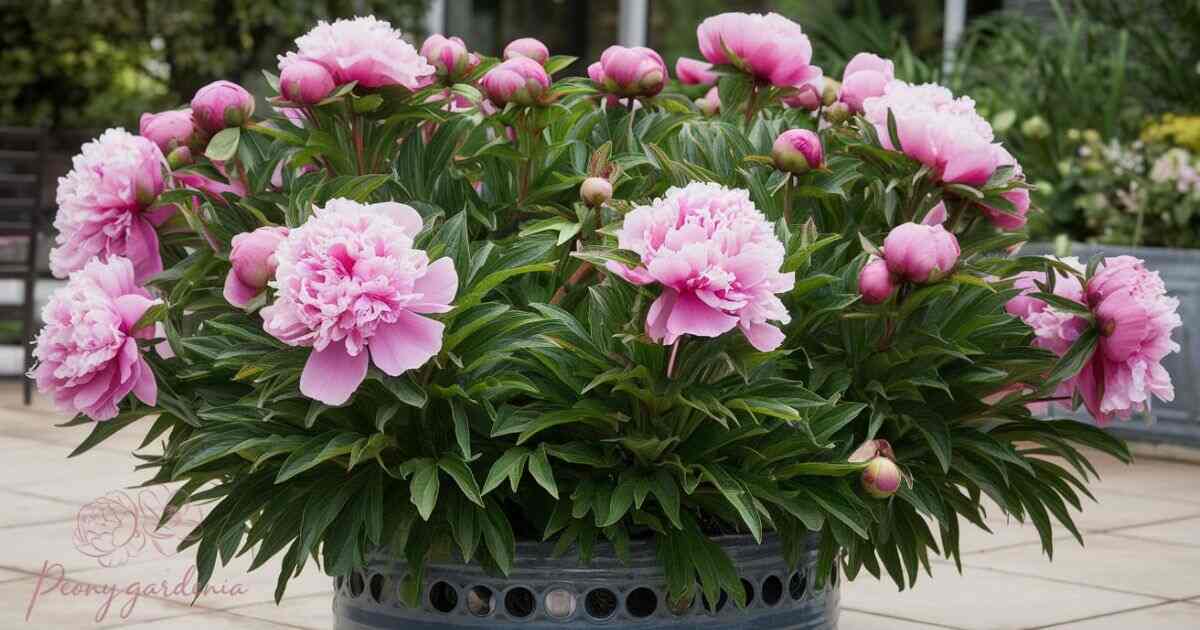Peonies are beloved for their stunning blooms and rich fragrance, making them a favorite in gardens. However, not everyone has the ideal garden space or soil conditions to grow these beautiful flowers. The good news is that with the right care and attention, peonies can thrive in containers, allowing gardeners with limited space or poor soil to enjoy their charm.
In this guide, we’ll explore everything you need to know about growing peonies in containers, from choosing the right varieties and containers to providing the proper soil, watering, and care. Whether you’re a seasoned gardener or a beginner, you can enjoy the beauty of peonies in any space with the right approach.
Choosing the Right Peonies for Containers
When selecting peonies for containers, it’s essential to choose varieties that adapt well to pots. Herbaceous peonies, for example, are great for containers because they are relatively compact compared to tree peonies. Tree peonies, though more challenging to grow in pots, can thrive with the right care, especially if you select a dwarf variety.
Peonies are generally classified into herbaceous, tree, and intersectional varieties. Herbaceous peonies are the easiest to grow in containers, offering a wide range of colors and sizes. Tree peonies, while more difficult, can be suitable for larger containers. Intersectional peonies, a hybrid between tree and herbaceous varieties, combine the best of both worlds and perform well in pots.
How to Grow Peonies in Containers
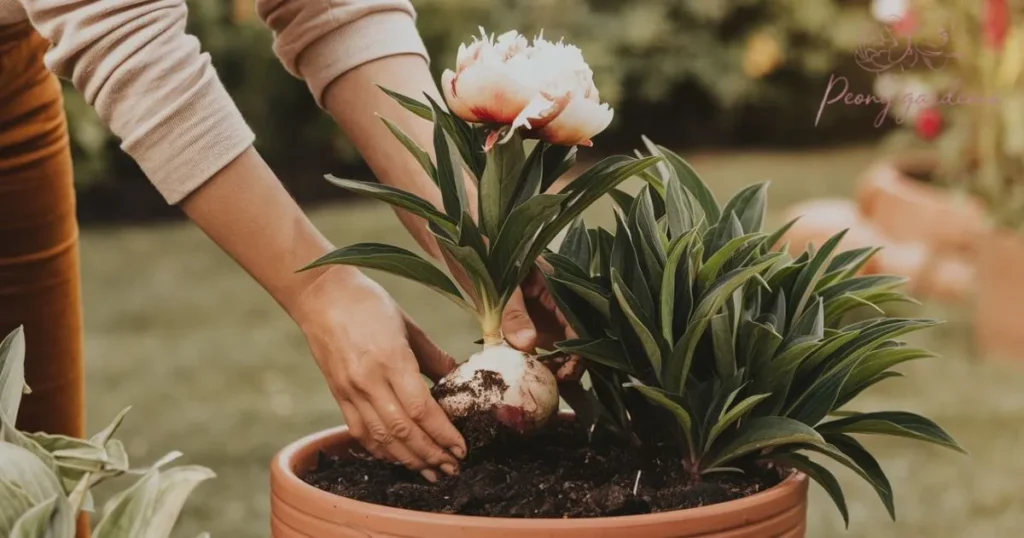
Growing peonies in containers is possible with the right care. Choose a large pot with good drainage, use well-draining soil, and select compact peony varieties like herbaceous or Itoh peonies. Place the container in a sunny spot, water regularly without overwatering, and ensure proper winter protection for healthy blooms.
Light
Peonies thrive in bright, full sunlight, making light one of the most important factors for healthy growth. For optimal blooming, peonies need at least six hours of direct sunlight each day. If grown in containers, place them in a location that receives abundant sun, such as a south or west-facing patio or balcony.
Insufficient sunlight can result in weak, spindly growth and fewer flowers. However, while peonies love sunlight, they can also tolerate some light shade, especially in hotter climates where the afternoon sun can be too harsh. Ensure that the plant gets enough light for strong, vibrant blooms.
Read More: How to Propagate Peonies
Temperature & Humidity
Peonies thrive in moderate temperatures and humidity, making them ideal for temperate climates. The optimal temperature range for peonies is between 60°F and 70°F (15-21°C), as they grow best in cooler conditions. They are cold-hardy and can tolerate frost, but extreme heat or prolonged hot spells can cause stress and reduce blooming.
Humidity is also a factor to consider; peonies prefer moderate humidity, as excessive moisture or dryness can lead to health problems like fungal diseases or wilting. Maintaining a balanced environment with adequate airflow is essential for ensuring peonies grow strong and produce beautiful blooms.
Water & Fertilizer
Watering and fertilizing are essential for the health and growth of peonies in containers. Peonies need consistent moisture, especially during their growing season, but it’s important to avoid overwatering, which can lead to root rot. Water thoroughly when the top inch of soil feels dry, ensuring the soil stays moist but not soggy.
As for fertilization, peonies benefit from a balanced, slow-release fertilizer applied in early spring and possibly again after flowering. Organic fertilizers, like compost or well-rotted manure, are also effective and can provide nutrients throughout the growing season. Regular, proper watering and fertilizing will promote strong blooms and healthy growth.
Soil & Compost
Peonies thrive in well-draining, nutrient-rich soil, making the right mix essential for their growth. A combination of garden soil, organic compost, and perlite or sand ensures good drainage while retaining the necessary moisture. Peonies prefer slightly alkaline soil, so adding lime if your soil is too acidic can help maintain the ideal pH level.
Compost is particularly beneficial as it enriches the soil with essential nutrients and improves its texture. By using a high-quality compost, you provide peonies with the organic matter needed for strong root development and vibrant blooms, making it a key element in their care.
Troubleshooting Peony Care in Pots
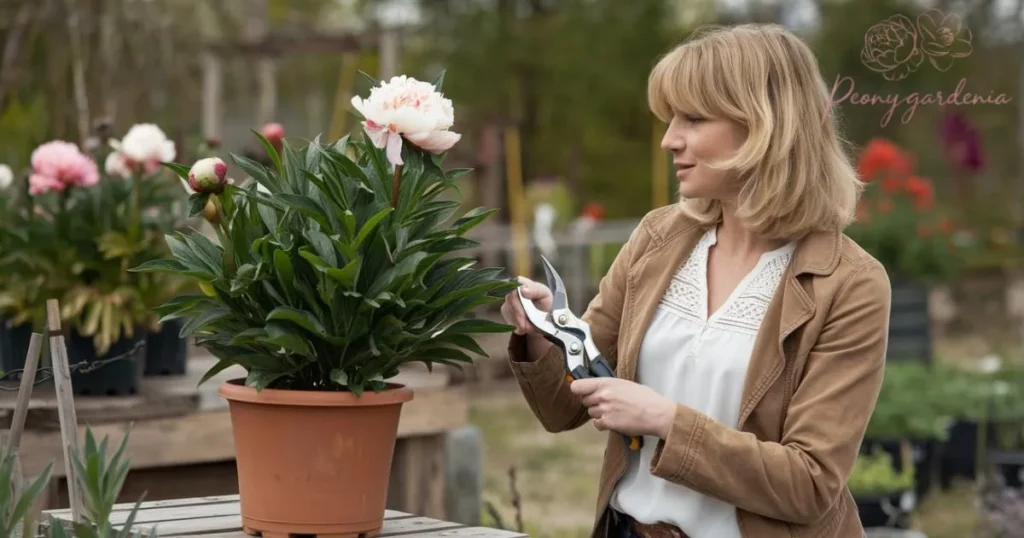
Growing peonies in containers can be incredibly rewarding, but there are common issues you may face. One of the main problems is poor drainage, which can lead to root rot. To prevent this, always ensure that your container has drainage holes, and use well-draining soil. Another issue is overcrowding—peonies need space to grow, and a small pot can stunt their growth.
Pests and diseases can also affect peonies grown in pots. Aphids, spider mites, and botrytis blight are common issues, but they can be managed with regular inspection. If you spot pests, use insecticidal soap or neem oil to treat the plant. For fungal diseases, ensure the peony isn’t overcrowded or overwatered, as this creates the perfect environment for fungi to thrive. Addressing these problems promptly will keep your peonies healthy and blooming beautifully.
Overwintering Peonies in Containers
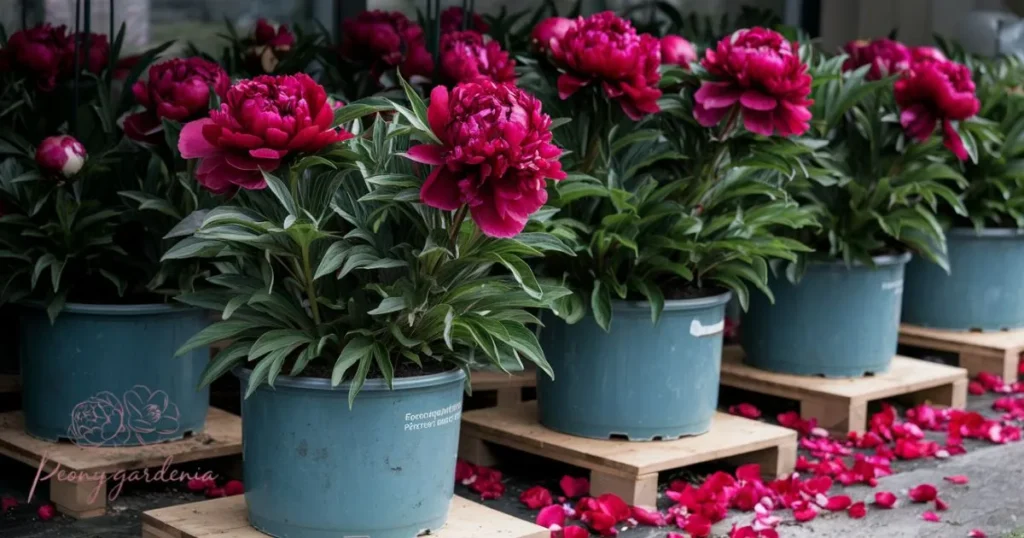
Overwintering peonies in containers requires a little extra effort, as pots can be more vulnerable to extreme temperatures. In colder climates, it’s best to move the container to a sheltered location, such as a garage, basement, or a covered porch, where the temperature stays above freezing. If moving the container is not possible, wrap the pot in burlap or bubble wrap to insulate it and protect the roots from the cold.
Alternatively, you can bury the container in the ground to provide extra insulation during the winter months. This helps keep the roots insulated from freezing temperatures. Before winter, reduce watering, as peonies are dormant during this period and don’t need much moisture. By taking these precautions, your potted peonies will survive the winter and be ready to bloom again in spring.
Maintaining Healthy Peony Plants
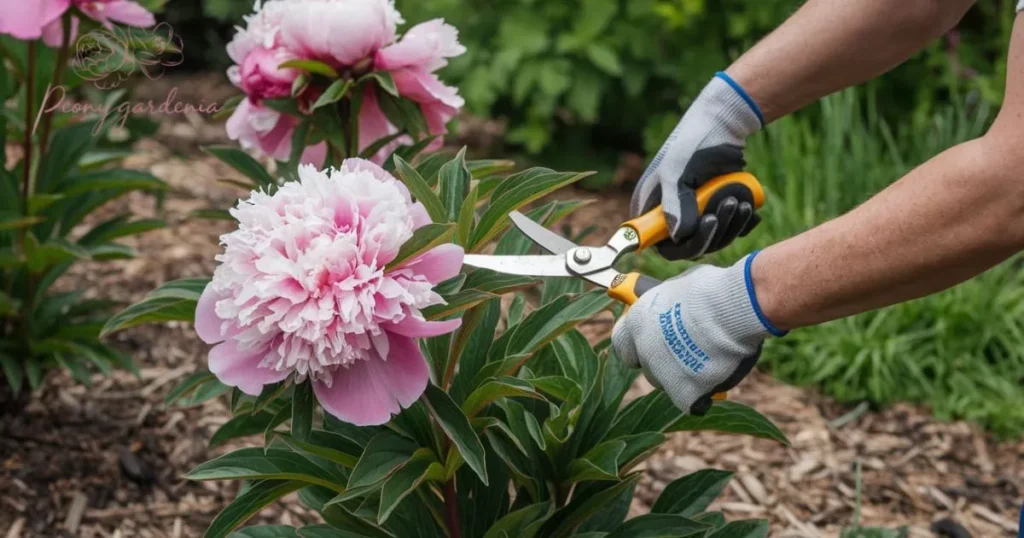
Peonies in containers require ongoing care to ensure they remain healthy year after year. A regular maintenance plan involves checking the soil for drainage and replenishing it with compost or organic matter as needed. After flowering, deadheads bloom to encourage new growth and prevent the plant from wasting energy on seed production.
In addition to basic maintenance, ensure that your peonies are protected from pests and diseases throughout the growing season. Monitor the plants regularly for any signs of stress, such as yellowing leaves or stunted growth. If your peony looks stressed, check its watering schedule, light exposure, and soil health to identify the issue. A healthy peony is a happy peony, and with the right care, your container-grown peony will continue to thrive for many seasons.
Conclusion
Growing peonies in containers is a rewarding way to enjoy these stunning flowers, even if you have limited garden space. By selecting the right peony varieties, such as herbaceous or dwarf tree peonies, and choosing an appropriately sized container with proper drainage, you set the foundation for successful growth.
Using nutrient-rich, well-draining soil and providing consistent watering and regular fertilization will help your to Growing peonies in containers. Additionally, be mindful of temperature, humidity, and potential pests to keep your plants healthy. Overwintering peonies in pots may require extra care, but with the right steps, your potted peonies will bloom beautifully season after season.
FAQ’s
Can peonies grow in small containers?
Peonies need large containers (at least 18-24 inches) for healthy growth.
How often should I water peonies in containers?
Water peonies when the top inch of soil feels dry, but avoid overwatering.
Can I grow tree peonies in containers?
Yes, but choose a dwarf variety and ensure the container is large enough.
Do peonies need full sunlight in containers?
Yes, peonies thrive in full sunlight for at least 6 hours a day.
How do I protect peonies from winter in containers?
Move containers to a sheltered area or insulate them to prevent freezing.
